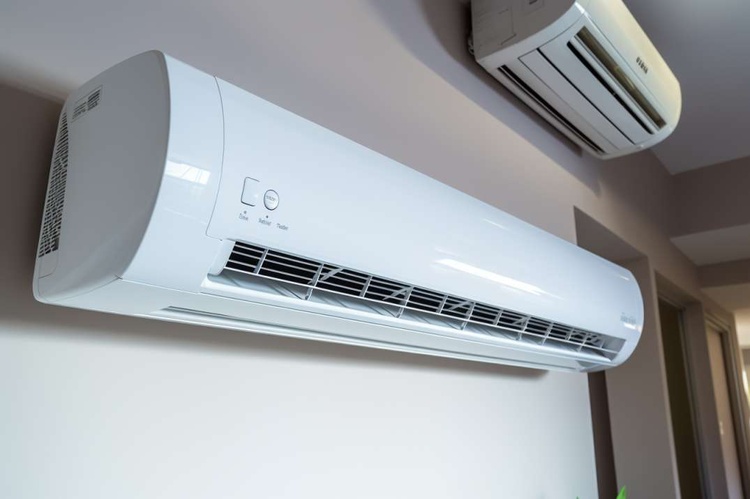Ductless Air Conditioning: A Comprehensive Guide to Efficient Cooling
Ductless air conditioning systems, also known as mini-split systems, are becoming increasingly popular for their energy efficiency and versatility. These innovative cooling solutions offer a range of benefits over traditional central air conditioning systems, making them an attractive option for homeowners and businesses alike. In this comprehensive guide, we'll explore the ins and outs of ductless air conditioning, helping you understand how these systems work and why they might be the perfect cooling solution for your space.

The system works by circulating refrigerant between the outdoor and indoor units. The outdoor unit compresses and cools the refrigerant, which is then sent to the indoor unit. As warm air from the room passes over the indoor unit’s evaporator coils, the refrigerant absorbs the heat, cooling the air before it’s circulated back into the space. This process continues until the desired temperature is reached, as monitored by the system’s thermostat.
What Are the Benefits of Ductless Air Conditioning?
Ductless air conditioning systems offer several advantages over traditional cooling methods. One of the most significant benefits is their energy efficiency. By eliminating the need for ductwork, these systems avoid the energy losses associated with leaky or poorly insulated ducts, which can account for up to 30% of energy consumption in conventional systems. Additionally, ductless systems allow for zoned cooling, meaning you can control the temperature in individual rooms or areas, further reducing energy waste.
Another advantage of ductless air conditioning is its flexibility in installation. These systems are ideal for homes or buildings where installing ductwork would be impractical or cost-prohibitive, such as older properties, additions, or spaces with limited room for ductwork. The compact size of the indoor units also makes them less obtrusive than traditional window air conditioners, preserving the aesthetics of your space.
How Does Ductless Air Conditioning Compare to Portable Air Conditioners?
While both ductless air conditioning and portable air conditioners offer cooling solutions without the need for extensive ductwork, they differ significantly in terms of efficiency, performance, and installation. Ductless systems are generally more energy-efficient and provide more consistent cooling than portable units. They also offer better air filtration and are much quieter during operation.
Portable air conditioners are typically less expensive upfront and can be moved from room to room, but they are less efficient and may struggle to cool larger spaces effectively. Ductless systems, while requiring professional installation, offer a more permanent and powerful cooling solution that can be integrated seamlessly into your home or office design.
What Should You Consider When Choosing a Ductless Air Conditioning System?
When selecting a ductless air conditioning system, several factors come into play. First, consider the size of the space you need to cool. Ductless systems are available in various capacities, measured in BTUs (British Thermal Units), and it’s crucial to choose a system that’s appropriately sized for your needs. An undersized system will struggle to cool effectively, while an oversized system may cycle on and off frequently, reducing efficiency and comfort.
Energy efficiency ratings are another important consideration. Look for systems with high SEER (Seasonal Energy Efficiency Ratio) ratings, which indicate greater energy efficiency. Many ductless systems also offer additional features such as programmable timers, remote control operation, and advanced air filtration systems, which can enhance comfort and convenience.
How Much Does Ductless Air Conditioning Cost?
The cost of ductless air conditioning systems can vary widely depending on factors such as the size of the space, the number of indoor units required, and the specific features of the system. Generally, ductless systems have a higher upfront cost compared to window units or portable air conditioners but offer long-term savings through improved energy efficiency.
| System Type | Capacity (BTUs) | Estimated Cost Range |
|---|---|---|
| Single Zone | 9,000 - 12,000 | $3,000 - $5,000 |
| Dual Zone | 18,000 - 24,000 | $5,000 - $8,000 |
| Triple Zone | 27,000 - 36,000 | $7,000 - $12,000 |
| Quad Zone | 36,000 - 48,000 | $9,000 - $15,000 |
Prices, rates, or cost estimates mentioned in this article are based on the latest available information but may change over time. Independent research is advised before making financial decisions.
While the initial investment may be higher than traditional cooling options, many homeowners find that the energy savings and increased comfort justify the cost. Additionally, some utility companies offer rebates or incentives for installing energy-efficient HVAC systems, which can help offset the upfront expenses.
Ductless air conditioning systems offer a versatile, efficient, and effective cooling solution for a wide range of applications. Whether you’re looking to cool a single room, retrofit an older building, or create customized comfort zones throughout your home, a ductless system could be the ideal choice. By understanding the technology, benefits, and considerations involved in choosing a ductless air conditioning system, you can make an informed decision about the best cooling solution for your specific needs.






